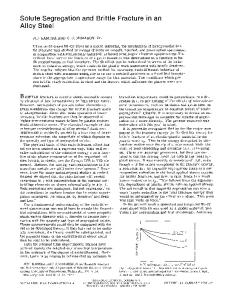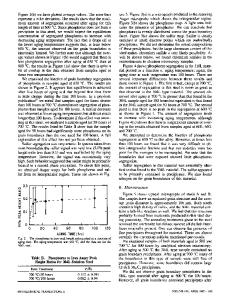Phosphorus and carbon segregation: Effects on fatigue and fracture of gas-carburized modified 4320 steel
- PDF / 3,076,987 Bytes
- 12 Pages / 598.28 x 778.28 pts Page_size
- 92 Downloads / 323 Views
I.
INTRODUCTION
A critical area of concern regarding the fatigue performance of carburized steels is the identification of fatigue crack initiation mechanisms. Bending fatigue cracks may be initiated at surface discontinuities, surface oxides, inclusions, or at embrittled prior austenite grain boundaries, tl] The latter mechanism of crack initiation is associated with phosphorus segregation to and cementite formation on austenite grain boundaries. ]2,3,4) Carbide formation and impurity element segregation in medium carbon steels have also been found to decrease the cohesive strength of the grain boundaries and significantly increase the sensitivity of hardened steels to intergranular fracture, t53 Phosphorus has been shown to segregate during austenitizing heat treatments ~6'71and appears to stimulate the formation of cementite during quenching. ~3,41 Auger electron spectroscopy (AES) has shown that the phosphorus grain-boundary concentration in AISI 52100 steel is 30 to 50 times greater than the bulk concentration? 3~ The segregation may be enhanced by rejection of phosphorus from carbides during quenching, as most embrittling species are insoluble in cementite, c3"8"9)Cementite is rarely observed by scanning electron microscopy (SEM) of integranular fracture surfaces. 131 However, AES observations of intergranular fracture surfaces show that the atomic ratio of carbon and iron correspond to that in cementite, and subsidiary peaks associated with the R.S. HYDE, Graduate Research Assistant, G. KRAUSS, John Henry Moore Professor, and D.K. MATLOCK, Fogarty Professor, are with Advanced Steel Processing and Products Research Center, Colorado School of Mines, Golden, CO 80401. Manuscript submitted July 14, 1993. METALLURGICAL AND MATERIALS TRANSACTIONS A
elemental carbon spectra indicate that carbon at the grain boundaries is in the form of cementite. In surface-hardened steels that are susceptible to intergranular fracture in the high-carbon case, typical bending fatigue failures nucleate as small surface regions of intergranular cracking (2 to 4 grains in depth) and grow by stable fatigue crack propagation to form larger semielliptical regions of transgranular cracking to a depth determined by the fracture toughness of the high-carbon case microstructure. Final fracture occurs within the case by overload intergranular cracking and undergoes a transition to microvoid coalescence as the crack propagates through the core of the specimen, tl~ Figure 1 shows this sequence of fatigue fracture in SEM micrographs of a carburized 4320 steel bending fatigue specimen, t'~ Figure 1(a) is an overview of the fatigue crack showing the small intergranular initiation, the semielliptical transgranular area, and a portion of the overload region. Figure l(b) is the fatigue crack in Figure l(a) with the transgranular region delineated by a dotted line and geometrical parameters a and c used for fracture toughness calculations. Figure l(c) is a higher magnification micrograph of the intergranular initiation site. Recently, it has been s
Data Loading...











